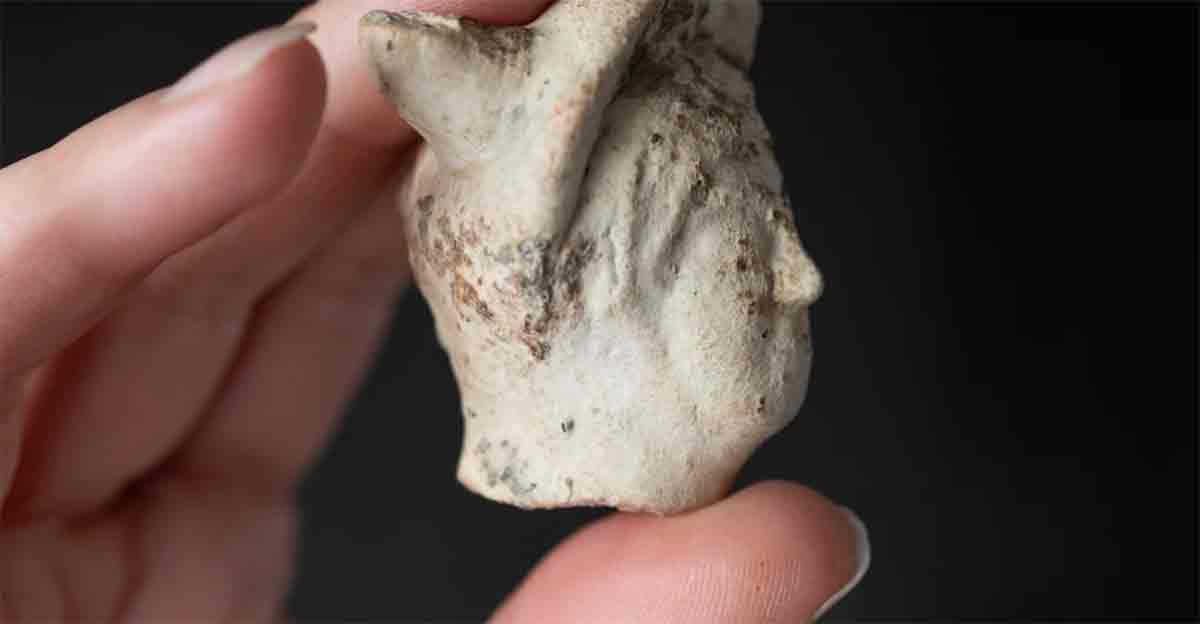Excavations in Kent Reveal Mercury Figurine and Roman Settlement
Excavations at Smallhythe Place in England’s Kent have revealed both a medieval shipbuilding site and an earlier Roman settlement. The latter yielded the unexpected find of the head of a figurine depicting the god Mercury. With only ten Mercury figurines having been known till date, archaeologists have been further excited. The 2,000-year-old head, along with other finds, indicate that a Roman settlement stood at this spot between the 1st and 3rd centuries.
- Romans Cleverly Used Interchangeable Heads on Their Statues
- For Sale in Britain: A Small Ancient Man with a Colossal Penis
Religious Practices in England: Decapitation of Mercury Figurine
The head of Mercury was crafted from pipeclay, a rarity in Britannia, as pipeclay figurines primarily originate from regions like central Gaul (modern-day France) and the Rhine-Moselle region, and were imported into Britain. However, while pipeclay examples are rare overall, the majority found in Britain depict female deities, particularly Venus, according to a statement published by The National Trust.
Mercury, known as the god of various domains including the fine arts, commerce, and financial success, was a significant figure in Roman religion. Statues and portable figurines of deities like Mercury were an integral part of daily religious practices for both the Roman elite and ordinary citizens, often worshipped within their homes, particularly during Britain's Roman period 43-410 AD.
The complete figurine of Mercury likely depicted him standing, adorned either with a chlamys (a short cloak) or in a naked form, possibly holding a caduceus (a staff with two intertwined snakes), symbols associated with the god.
“Few single pipeclay heads are known in Britain, some of which may have been votive offerings. Finds like this at Smallhythe provide an extremely valuable insight into the religious beliefs and practices of the culturally mixed populations of the Roman provinces,” said Dr. Matthew Fittock, an expert on ceramic figurines in Roman Britain, who’d worked at the site.
- Roman Venus Statues Found Amongst the Garbage
- High-Tech Scans Prove Austria’s Venus of Willendorf Originated in Italy

Mercury head held by National Trust Archaeologist Nathalie Cohen. (© National Trust Images/James Dobson)
The discovery of the 5cm-tall (2in) head of Mercury without a corresponding body is interesting, especially considering the evidence suggesting that deliberately breaking certain figurine heads was part of an important ritual, reports BBC.
“Pipeclay figurines were mainly used by civilians for private religious practice in domestic shrines and occasionally in temples and the graves of often sick children,” explained Dr. Fittock. “Rather than pieces being discarded because they were broken, there is evidence to suggest that deliberately breaking some figurine heads was an important ritual practice, whereas whole figurines are usually found in graves.”
In ancient Roman religious practices, it was not uncommon for certain rituals to involve the deliberate destruction or manipulation of religious objects, including figurines and statues. This act of intentionally breaking or separating the head from the body of a figurine could have held symbolic significance within the context of religious rituals or ceremonies.
National Trust archaeologist Nathalie Cohen said, "To come across a head of a figurine of Mercury, in pipeclay, is incredibly rare. The head is clearly visible as Mercury, with his winged headdress. We sadly did not find the remaining part of the figurine."
One possible interpretation is that the act of separating the head from the body symbolized a form of ritualized "killing" or deactivation of the deity represented by the figurine. This symbolic act could have been performed as part of specific religious rites, perhaps aimed at invoking or appeasing the deity in question, or as a means of ensuring divine favor or protection. Alternatively, the deliberate breaking of figurine heads could have served as a form of ritual closure or termination, marking the end of a particular religious ceremony or phase of worship.
Smallythe Place: Rich Archaeological History
Smallhythe Place has been the focus of extensive archaeological investigations spanning several years, particularly concerning its historical significance as a medieval shipyard situated along the River Rother. It remains one of the most important royal shipbuilding centers in medieval England.
The site of the settlement in the modern hamlet of Small Hythe (or Smallhythe), located near Tenterden in Kent, holds historical significance as an important link in the Roman Empire's import and infrastructure network in southern England and the Channel region, reports The Guardian.

A view of Smallhythe Place. Excavation work taking place on medieval and post-medieval buildings in 2022. (© National Trust Images/Sam Milling)
Although the area now appears as fields, it was once a vital part of the Roman Empire's trade and transportation network in southern England. The settlement was small in scale and modest in prestige, added Cohen. “It’s not Roman Londinium, it’s not Cirencester. It’s a smallish settlement by a port.” That said, “it would have been vital in the logistics chain for exporting timber and iron out of [south-east England] and importing materials from the continent”.
The coastline in this region, including Kent, has undergone significant changes since the Roman era due to factors such as large-scale land drainage and reclamation, as well as the natural silting of river estuaries over time. Archaeological investigations conducted in the 1990s uncovered evidence of a medieval shipyard in Small Hythe, which was believed to have been visited by King Henry V.
Top image: Mercury figurine was discovered in Kent, England and dates back 2,000 years. Source: © National Trust Images/James Dobson
By Sahir Pandey
References
Addley, E. ‘Very rare’ clay figurine of Mercury discovered at Roman site in Kent. Available at: https://www.theguardian.com/science/2024/feb/23/very-rare-clay-figurine-mercury-roman-site-kent-small-hythe.
Geggel, L. 2024. 'Incredibly rare' head of deity Mercury reveals previously unknown Roman settlement in UK. Available at: https://www.livescience.com/archaeology/romans/incredibly-rare-head-of-deity-mercury-reveals-previously-unknown-roman-settlement-in-uk.
Maisner, S. 2024. Smallhythe Place: Rare Roman head of Mercury found during dig. Available at: https://www.bbc.com/news/uk-england-kent-68358986.
Milligan, M. 2024. Excavation of medieval shipbuilders reveals a Roman head of Mercury. Available at: https://www.heritagedaily.com/2024/02/excavation-of-medieval-shipbuilders-reveals-a-roman-head-of-mercury/150673.

















